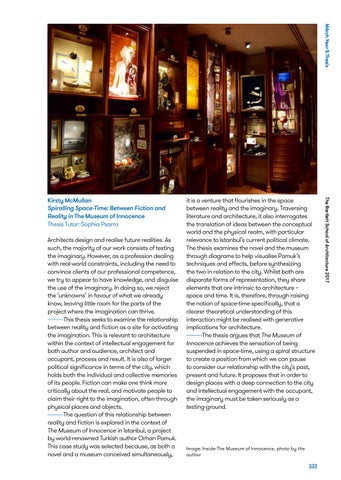MArch Year 5 Thesis
Architects design and realise future realities. As such, the majority of our work consists of testing the imaginary. However, as a profession dealing with real-world constraints, including the need to convince clients of our professional competence, we try to appear to have knowledge, and disguise the use of the imaginary. In doing so, we reject the ‘unknowns’ in favour of what we already know, leaving little room for the parts of the project where the imagination can thrive. This thesis seeks to examine the relationship between reality and fiction as a site for activating the imagination. This is relevant to architecture within the context of intellectual engagement for both author and audience, architect and occupant, process and result. It is also of larger political significance in terms of the city, which holds both the individual and collective memories of its people. Fiction can make one think more critically about the real, and motivate people to claim their right to the imagination, often through physical places and objects. The question of this relationship between reality and fiction is explored in the context of The Museum of Innocence in Istanbul, a project by world-renowned Turkish author Orhan Pamuk. This case study was selected because, as both a novel and a museum conceived simultaneously,
it is a venture that flourishes in the space between reality and the imaginary. Traversing literature and architecture, it also interrogates the translation of ideas between the conceptual world and the physical realm, with particular relevance to Istanbul’s current political climate. The thesis examines the novel and the museum through diagrams to help visualise Pamuk’s techniques and effects, before synthesizing the two in relation to the city. Whilst both are disparate forms of representation, they share elements that are intrinsic to architecture – space and time. It is, therefore, through raising the notion of space-time specifically, that a clearer theoretical understanding of this interaction might be realised with generative implications for architecture. The thesis argues that The Museum of Innocence achieves the sensation of being suspended in space-time, using a spiral structure to create a position from which we can pause to consider our relationship with the city’s past, present and future. It proposes that in order to design places with a deep connection to the city and intellectual engagement with the occupant, the imaginary must be taken seriously as a testing-ground.
Image: Inside The Museum of Innocence, photo by the author 333
The Bartlett School of Architecture 2017
Kirsty McMullan Spiralling Space-Time: Between Fiction and Reality in The Museum of Innocence Thesis Tutor: Sophia Psarra
